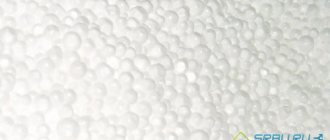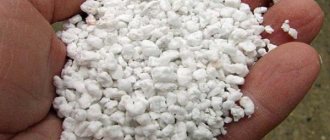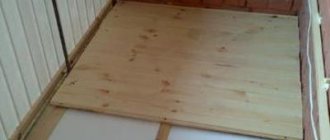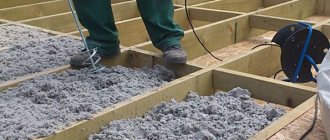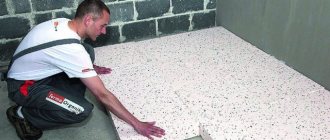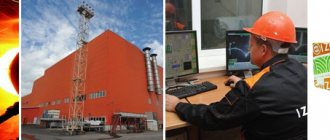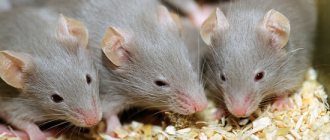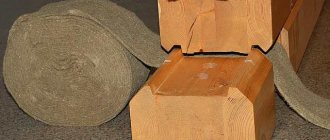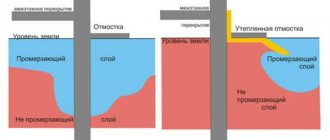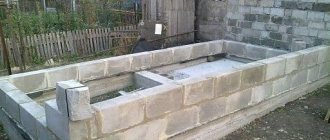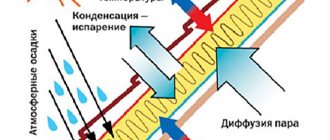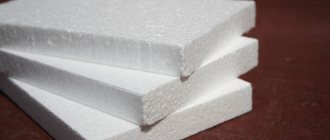Technical characteristics of insulation
Expanded porous perlite made from rock is used for insulation
Rock is formed in a lava flow during a volcanic eruption. It is formed as a result of the action of groundwater on volcanic glass. The mineral has a specific structure and easily breaks down into separate round parts - pearls. Another distinctive feature of porous rock is its water content of about 1% of the total volume.
In construction, expanded perlite insulation is used, which has undergone heat treatment in ovens at a temperature of 1100°C. When heated, moisture evaporates, giving the mineral a porous structure and increasing its size several times. The material becomes light and acquires heat-insulating properties. It is manufactured with different fraction sizes from fine sand to crushed stone. The dimensions of construction perlite are 0.16-1.25 mm, agroperlite – 1-5 mm. Perlite sand has a wide variation in density - 40-200 kg/m3.
Specifications:
- thermal conductivity – 0.043-0.052 W/m*K;
- humidity by weight – no more than 2%;
- unevenness of grain sizes – up to 15% by volume of the product;
- moisture absorption – up to 400% of its own weight.
The insulation is chemically neutral and is not affected by alkalis and weak acids. It does not rot under the influence of moisture, microorganisms and rodents do not live in it. The heat insulator is used in a wide temperature range from -200°C to +900°C. The material is environmentally friendly for people and does not contain toxic impurities or heavy metals.
Comparison with vermiculite
Vermiculite is a more durable material compared to perlite.
Among bulk insulation materials, the choice is usually made of two minerals - agroperlite or vermiculite. An unambiguous conclusion can be drawn by comparing their characteristics. Vermiculite is a layered dense material. In construction it is used in expanded form. The mineral is heated to temperatures above 1000°C, and during processing it increases in volume up to 20 times.
A significant advantage of vermiculite is its elasticity. Unlike perlite, it does not deform or crumble under its own weight. The insulation is heat-resistant and environmentally friendly. The high hygroscopicity of the backfill requires high-quality ventilation on the roof.
The physical and technical properties of the materials are similar to each other. Bulk substances differ in appearance: light perlite, brown vermiculite. The thermal insulation properties of perlite insulation are slightly higher than those of vermiculite. But the main factor in favor of volcanic glass insulation is its low cost. The material costs 2-3 times less than vermiculite, therefore it is more popular in construction.
Pros and cons of perlite
Perlite plaster also has heat-insulating properties
When choosing bulk insulation, consumers have to compare several materials: expanded clay, expanded polystyrene granules, vermiculite or perlite. Each variety has characteristics that are taken into account when making a decision. Loose-fill volcanic glass insulation is highly effective. The material does not shrink like granulated polystyrene foam and does not get wet like expanded clay. The main advantages of insulation are:
- Low thermal conductivity of perlite, which is provided by many voids in the porous structure of the mineral. Also, the structure of the mineral contributes to effective noise absorption.
- Light weight, allowing up to 40% reduction in the total weight of the structure. Light load-bearing walls do not require a massive foundation.
- The ability to operate in different temperature ranges does not limit the use of the material.
- Fire resistance guarantees the fire safety of the insulation. It is able to stop the spread of fire. When heated, it does not emit smoke or toxic substances.
- The natural mineral is environmentally friendly and contains no harmful impurities.
- Loose insulation evenly fills the space, fits tightly, leaving no cold bridges. The material does not cause difficulties when filling like foam granules.
Fragility is the main disadvantage of perlite. The mineral is easily destroyed, turning into dust. The material loses weight during open transportation and creates inconvenience during backfilling. Working with it requires the use of protective equipment: respirators, goggles, gloves. To make sand less dusty, it is moistened with water before use.
Perlite's ability to absorb moisture is not always a negative characteristic. It can easily release water in the form of steam. The material prevents condensation from appearing on the walls. For normal operation of the insulation, it is necessary to ensure the removal of excess moisture to the outside.
Types of material
Only four types of this thermal insulation material are produced. All of them differ from each other not only in the installation method and technical characteristics.
Main types of perlite:
- The backfill form or sand is lighter than other subtypes. Therefore, it is used for thermal insulation of partitions and at the same time to facilitate the finished structure of any building. Another essence of its use is to eliminate gap-like, interfloor layers, and fill other voids. It is used for adjusting floors, sometimes as plastering surfaces.
- Plates. This type is most common in production, as it is the most popular of perlites. Great demand is due to the convenience of the form for the quick construction of any size structure or area. With high hygroscopicity, it is therefore more appropriate to use it for interior work. If used outside buildings, it is imperative to add a layer of moisture-proof material. Manufactured using hydraulic pressing. Depending on the needs, various binding materials are used: polymers, liquid glass, lime, cement, bitumen and others combined with it.
- A roofing variety, which is more often called bitumen perlite after the name of the binder used in production. This material makes it possible to easily install insulating structures of a wide variety of shapes due to its increased flexibility. Any roof or other non-standard structure will have a decent level of thermal conductivity. This makes it possible to use these roofing forms in construction at low negative thermometer readings. Being non-flammable, it will provide the structure with adequate fire protection.
- Dry mixtures for construction purposes, made using fine perlite and a mixture of cement. Only the required amount of water must be added to such a workpiece mass to obtain a ready-to-use mortar. It is effectively used for grouting various kinds of seams, cavities formed during masonry, cracks and similar voids. Using a dry mixture you can get a special plaster. It is applied in a layer to any surface, easily leveling it and paralleling it, increasing the thermal insulation coefficient for the entire structure.
For construction needs, the production of three main grades of perlite has been established:
- M75;
- M100;
- M150.
The above numbers in the marking determine the density coefficient of the material. This indicator is extremely important for the type of future installation work and the operating conditions of the raw materials.
But any of these density characteristics allows perlite in the solution state to be so fluid as to be able to fill the smallest voids in the structure. This is one of the main advantages of this material over analogues that are applicable in similar construction processes.
Application area
For flowers, perlite is used as a leavening agent.
In its natural form, the mineral is used in various economic fields:
- the food and medical industries use the mineral as a cleaning filter;
- Perlite loosening additives are popular in agriculture.
When constructing buildings, expanded perlite is usually used. It allows you to ensure optimal sound and heat insulation of walls, floors, and roofs. The insulation is effective when the backfill and composition of the insulating products are uniform. It is used to fill the masonry of external and internal walls, when installing a heated floor system, and insulating floors.
Wall insulation
Walls between two rows of bricks are insulated with perlite
Characteristics of Perlite in the form of sand
Basic properties - they are also advantages
It is worth noting the main advantages that perlite insulation has:
- Little weight. Despite the fact that rocks and volcanic rocks are used as raw materials, Perlite is quite light (this is achieved through heat treatment). As a result, there is no need to build a particularly strong frame.
- Increased temperature resistance. It can withstand temperature changes from −220 to +900 degrees. Therefore, it can be freely used for external insulation even in the far north.
Important! In this aspect, it beats all its competitors. No other insulation can boast of a permissible amplitude of over 1100 degrees.
- Environmental Safety. Even when heated, this material does not emit any toxic substances or carcinogens.
- Chemical neutrality to most acids and alkalis. This eliminates the possibility of corrosion and other unpleasant formations. It should also be noted that it is completely hypoallergenic.
- High sound-absorbing properties, which are achieved due to low bulk density. As a result, when using this insulation, there is no need to lay an additional soundproofing layer.
- Does not deform as a result of heating. Therefore, Perlite is often used in underfloor heating systems.
- High efficiency. In general, stating the features presented above, we can note the impressive efficiency of this material. Despite the fact that it is not very popular (relative to Penoplex and mineral wool), its use seems to be very rational. At the same time, the cost of this material is in the average range.
Where is this material used?
Such an impressive list of advantages predetermined the wide range of application of this insulation:
- External plastering of buildings. Here frost resistance comes to the fore.
- Any internal work related to leveling and increasing thermal conductivity properties.
- Interior roof finishing.
- Thermal insulation of pipelines (including hot water supply).
- Warm floor systems.
Above are only the broadest construction areas. The substance itself, called Perlite, is used in medicine, metallurgy, energy, agriculture, oil refining and even the food industry.
We study all known varieties
In total, there are 4 forms of release of this insulation: backfill (it is also called sand), slabs (outwardly similar to penoplex), roofing models and dry building mixtures. These varieties have some features that you should know.
Backfill insulation
The first form factor of Perlite to emerge was loose insulation. The main task of this material in the construction of houses is to lighten the structure (it is lighter than a standard cement-sand mixture) and increase its thermal insulation qualities. This layer is usually used for backfilling floors and interfloor layers. It is also often used to fill voids in wall masonry. Less often it is used in combination with (or instead of) warm plaster.
The most convenient and practical form is slabs
According to official statistics, about 60% of all Perlite produced on the planet goes to create thermal insulation boards. They are obtained by hydraulic pressing, making them very convenient to use. The binder may differ depending on the specific type (bitumen, lime, polymer compounds, cement, liquid glass, etc.).
This category of materials has quite high hygroscopicity. Therefore, it is mostly used for interior decoration. However, when laying an additional moisture-proof layer, it can also be used for exterior finishing. However, this is not very justified from an economic point of view.
Types of perlite insulation
The specified wall insulation is produced in different forms and their characteristics are slightly different.
Backfill insulation
Perlite sand for wall insulation is the lightest. Thanks to it, you can lighten any design. The material is used to create layers between floors, fill cracks, and other voids. Using this form of insulation, you can adjust the floor to the required level and plaster the walls. The material reduces heat loss by 40%.
Perlite in the form of slabs
The slab form of insulation is produced more often than others, as it is convenient to use and makes it possible to quickly carry out installation work. The material is hygroscopic, so it should not be used for outdoor use. If such a need arises, then a waterproofing layer is required. The production of plates involves hydraulic pressing of raw materials. The material contains other components that improve technical characteristics: cement, polymer substances, lime, liquid glass, bitumen.
Roofing models
Perlite as insulation is used to insulate roofing systems. The binder in the product is bitumen. Its characteristic feature is increased flexibility, as a result of which structures of any shape and type of complexity can be insulated. In addition to its thermal insulation properties, the material provides reliable protection of the roofing system from fire.
To fasten the product, it does not require pre-heating, as is the case with other bitumen-containing products. The low thermal conductivity coefficient will allow the insulation to be used in northern regions.
Dry building mixtures based on perlite
It is possible not only to insulate walls with perlite, but also to use the material for the production of building mixtures. In this case, fine-grained raw materials with the addition of cement are required. The mixture must be diluted with sufficient water. The solution is intended for grouting cracks and seams. Raw materials are added to plasters to achieve a thermal insulation effect. Perlite is added not only to cement, but also to gypsum and lime compositions.
Perlite-based plaster is resistant to fire, does not weigh down the walls, does not rot and is inert to the influence of negative temperatures. The product has good adhesion to the surface. The finishing provides high-quality sound insulation and helps retain heat in the room.
Criterias of choice
To select a thermal insulation material with high technical characteristics, you should determine the product labeling. Three main classes of perlite are used in construction - M75, M100 and M150.
The numbers indicated in the markings indicate the bulk density of the material. Which corresponds to thermal conductivity - 0.043, 0.052 and 0.058 Watt/m °C. The lighter the perlite, the higher its heat and sound insulation properties.
The expanded rock is divided into different fractions. For construction, perlite with granules ranging in size from 0.16 to 1.25 millimeters is used. The larger the constituent particles of the material, the lower the level of its fluidity, which worsens the quality of the insulation backfill.
When purchasing perlite for thermal insulation, you should pay attention to the integrity of the packaging and storage conditions. If the material was in a humid environment for a long time, its quality decreased significantly. Another important aspect of the choice is the manufacturer. Some unscrupulous sellers may pass off an artificial construction product as natural foamed perlite.
Perlite: a new word in the insulation market
Perlite is considered a universal material used as insulation for walls and floors. This is volcanic acid glass. The raw material can be obtained by sharp heating to 1100 degrees, when it swells. The fractional composition is different. Various components are added to the raw material to improve heat and sound insulation properties.
Today this insulation is considered one of the most effective in the world. Thanks to its special properties, the product is used not only in construction, but also in other areas. The largest producer of perlite is the USA.
DIY insulation technology
The process of blowing in expanded perlite sand is not labor-intensive and takes little time. Seams and cracks on walls and cavities in blocks can be perfectly filled with perlite-based mortar, which can be easily made with your own hands by selecting the necessary materials.
Materials
In terms of thermal insulation properties, perlite sand, 30 mm thick, is equivalent to sand-lime brick, 200 mm thick, and mortars with the addition of volcanic sand are effective insulation.
The following are added as binding materials:
- liquid glass;
- cement;
- bitumen;
- clay, lime;
- gypsum.
A mixture of perlite and a binder is made in belt mixers at low speeds so as not to disturb the structure of the perlite grain.
From building mixtures you can press products of various shapes, make bricks and other necessary structures.
Sequence of work
Work on insulating the house begins with laying the foundation:
- the bases of strip foundations and basements are plastered with mixtures containing perlite chips and insulated with heat-insulating blocks;
- when constructing walls, perlite expanded sand is backfilled every 3-4 rows of masonry, compacting it;
- Next, a layer of plaster no more than 5 cm thick is applied to the walls.
The voids are filled based on the bulk density for each cubic meter - 70-100 kg of perlite component.
Upon completion of the construction of the walls, they are covered with ceiling slabs, all cracks are carefully sealed and the insulation of the ceiling begins:
- cover the slabs with cardboard or paper;
- pour expanded perlite sand 3 cm thick onto it and compact it;
- filled with cement.
Insulation Features
Insulation can be laid in different ways, it all depends on the type of material. If you need to fill it up, then this should be done directly from the bag. In this case, a convenient interval must be observed. You need to check the material to ensure it is dry. If there are cracks or holes in the walls, they need to be sealed so that the perlite does not spill out.
Wall cavities located under windows and doorways are subject to insulation. If necessary, the material is compacted. Insulation is also required between the exterior masonry and the interior finishing.
Operational life
Perlite chips have excellent performance qualities. It has been performing its functions for many years, maintaining its original condition without losing its visual appeal.
The service life of perlite is unlimited, unless it is damaged mechanically.
Perlite has high physical and technical properties, which is why it is so in demand; it is the best among thermal insulation materials.
When purchasing, you need to be vigilant - it is not so easy to find expanded perlite chips on the market and unscrupulous sellers can pass off a fake as real perlite.
Advantages and disadvantages of penofol
This material is polyethylene, which is foamed during production and covered with an aluminum coating, which reaches a thickness of 14 microns and has a purity of 99.4%. The material can be coated with aluminum on different sides or on both sides at the same time.
Its class and properties of heat and vapor barrier depend on this.
First of all, you should familiarize yourself with its positive characteristics, which play a significant role when choosing a material for insulation:
- High degree of environmental friendliness . The components from which this insulation is produced are non-toxic, since their use is permitted for storing food products.
- Minimum thickness value . Similar insulation materials usually exceed a thickness of 4 mm. If we compare penofol and mineral wool, then 8.5 cm of the second material can provide the same insulation properties.
- There is no need to use vapor barrier materials , because penofol is characterized by a low level of vapor permeability.
- High noise insulation properties , which allows for acoustic and structural sound insulation without additional costs.
- The installation process is quite simple ; there is no need for special clothing or the use of specialized equipment.
- The insulation is not subject to fire.
- Easy transportation , the insulation can be rolled up and packed into a passenger car.
- Rodents do not damage such material.
- Each batch produced undergoes mandatory certification at the sanitary and epidemiological station.
Specifications
In addition to the positive aspects, it is also worth noting other nuances, which in some cases are disadvantages when using penofol:
- Due to the softness of the insulation, it cannot be used for internal insulation in the case of walls decorated with plaster or wallpaper.
- Difficulties in attaching all classes of material except C, which is equipped with a self-adhesive coating. It is better to make the connection using adhesive compounds; it is believed that nailing penofol worsens its properties as insulation.
- Penofol is significantly inferior in its characteristics to other types of insulation.
Types of penofol
This insulation is mainly used for finishing the walls of a house or apartment from the inside . If there is a need to insulate the house from the outside, then it is better to choose another type of heat-insulating composition, and use penofol as an additional layer, thereby enhancing the properties of reflecting thermal energy.
Comparison of perlite with other thermal insulators
To thoroughly understand all the advantages of this material, it is necessary to compare it with existing analogues:
- Vermiculite. The production technology of this heat insulator is similar. However, having a porous structure, this material has higher thermal conductivity. In addition, it is more expensive in price;
- Expanded polystyrene. It is difficult to fill cavities in walls with this heat insulator. In addition, it is flammable and releases toxic substances when burned;
- Expanded clay. It is considered one of the most common insulating materials. And although it is as cheap as perlite, its thermal conductivity is 2 times higher than the latter. However, it is completely unsuitable for thermal insulation of door and window openings;
Scope of application of perlite as insulation
Since insulation is available in different forms, it can be used in different areas. Perlite is used in:
- energy;
- construction of private and multi-storey buildings;
- metallurgical, food and oil refining industries;
- medicine.
Insulation can be used for external plastering of building walls, when leveling and insulating internal surfaces. In this way, not only heat conservation is ensured, but also a change in the acoustic properties of the structure. Perlite is required to treat the roof. The material is also used in the installation of heated floors.
Perlite sand is used for making building mixtures. They are suitable for filling seams, cracks, cavities in walls, providing thermal insulation properties.
Perlite: composition and properties
As a result of a volcanic eruption, lava comes into contact with the soil surface. Glass inclusions immediately form at the edge of this flow. Subsequently, under the influence of groundwater, a hydration process occurs, which leads to the formation of perlite. If you need to find out what it is, you need to consider the insulation production technology.
In its original form, the material is unremarkable. To give the desired properties, it is processed. It is necessary to achieve swelling of perlite. To do this, the rock is heated to 1100°C. As a result, the pores of the material explode. This process is called swelling. It leads to the disintegration of the rock into many fractions. Specifications:
- high degree of porosity (70-90%), which is due to the sharp heating of the rock and the transition of the liquid contained in its composition into a gaseous state;
- the rounded shape of the fractions with shine, which gives them a resemblance to pearls;
- bulk density varies depending on the size of individual particles: 45-200 kg/m³ (for sand), reaches 500 kg/m³ (if perlite-crushed stone insulation is considered);
- the size of the fractions varies from 1 to 10 mm;
- not exposed to fire, resistant to high temperatures (up to 900°C);
- relatively low thermal conductivity: from 0.043 to 0.053 W/(m*K);
- perlite is a hygroscopic material due to its large-porous structure, but after contact with liquids the fractions do not lose their properties;
- light weight;
- provides sound insulation;
- long service period;
- the quality of the material is not affected by aggressive compounds;
- the insulation does not contain harmful impurities;
- does not rot;
- perlite is resistant to mold;
- the material is unattractive to insects and rodents.
Building mixtures based on bulk perlite are often prepared; slabs, wall products, and blocks are used. The wide range of applications is due to the many useful properties of this material . It contains:
- silica;
- oxides of potassium, aluminum, magnesium, iron, sodium, calcium;
- water (1%).
There are several types of this material, the difference between the options lies in the size of the fractions.
Perlite concrete
The building material represents a group of lightweight concrete. It is used as an additive because it has good sound and heat insulation characteristics. As a result of its use in construction, several problems are solved at once: strength is ensured, and the intensity of heat loss and noise is reduced. To make concrete mortar, perlite should be used, the size of the fractions varies from 0.16 to 2.5 mm.
Composition of perlite concrete: water, Portland cement, sand, expanded perlite. The volume of components may vary. It all depends on the degree of density of the material that needs to be obtained. Properties of perlite concrete:
- resistance to fire;
- breathability;
- there are no harmful compounds in the composition;
- light weight, which allows you to build structures on your own.
This material is often contrasted with expanded clay concrete, aerated concrete, and polystyrene concrete. In order not to waste time making the mixture, you can purchase ready-made blocks. Products made from perlite concrete are more often used in the construction of low-rise buildings. The lower limit of the density limit is 600 kg/m³.
The block, made of perlite concrete, is distinguished by its large dimensions. For comparison, it can replace 3-4 bricks. Due to the low weight of the product, it is easy to install. This process is accelerated because instead of several bricks it is necessary to use 1 block of perlite concrete. The standard dimensions of such products (length, height) are 390x190 mm. The width varies between 70-190 mm.
Comparative characteristics
The main competitor of agroperlite in a similar field of application is considered to be expanded vermiculite (see figure).
Appearance of agroperlite and expanded vermiculite
This product is obtained in a similar way from intrusive (simply “under-erupted”) rocks - hydromicas. But from the point of view of agricultural technology, expanded vermiculite and perlite are significantly different preparations. Vermiculite is absolutely safe, but much more expensive; there are no synthetic substitutes, and falsification using artisanal methods is impossible. Expanded vermiculite is significantly less permeable to air than perlite; in fact, it is not blown and therefore can become a breeding ground for phytopathogens. The shelf life in the soil and the total moisture capacity of vermiculite are greater than perlite, and the exchangeable moisture capacity is many times greater, so it is a good hydraulic accumulator. Figuratively speaking, vermiculite is not a wick, but a finely porous sponge. In addition, it contains microelements for plant nutrition, and the main ones are potassium. In the substrate under plants, vermiculite actively participates in soil ion exchange, and, as a result, acts as a battery and fertilizer dispenser. However, vermiculite is unsuitable as an ameliorant: it either does not work on poor soils or produces effects opposite to those of perlite, i.e. negative – waterlogging, acidification, moss, overgrowing by weeds or alkalization and/or weathering, overgrowing with halophytes (saltgrass, etc.). On ordinary garden soil, perlite and vermiculite as fillers act in approximately the same way, which explains some of the confusion with them in popular sources.
Comparative characteristics of expanded perlite and vermiculite for agricultural technology purposes are summarized in the table:
Appearance of perlite and vermiculite mulch
But vermiculite mulch also creates a variegated background that does a good job of masking both light and dark pests, poses. B. So this is a common drawback of both perlite and vermiculite mulches. Just like anyone else. The advantage of perlite in open ground gardens and greenhouses is also the creation of a “steam cocoon” around plants, which enhances the systemic and translaminar effect of pesticides, but this effect cannot always be recognized as an advantage. Unless, when clearing land of weeds, glyphosate allows you to reduce the dosage of the drug to the minimum. But the question is: how to stuff perlite under the roots of rampant weeds? - remains unanswered.
